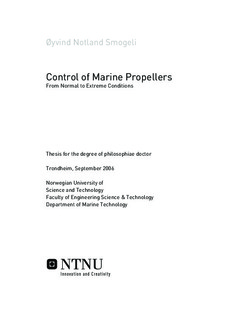| dc.description.abstract | This is a thesis about control of marine propellers. All ships and underwater vehicles, as well as an increasing number of offshore exploration and exploitation vessels, are controlled by proper action of their propulsion systems. For safe and cost effective operations, high performance vessel control systems are needed. To achieve this, all parts of the vessel control system, including both plant level and low-level control, must be addressed. However, limited attention has earlier been given to the effects of the propulsion system dynamics. The possible consequences of improper thruster control are:
• Decreased closed-loop vessel performance due to inaccurate thrust production
• Increased vessel down-time and maintenance cost due to unnecessary mechanical wear and tear.
• Increased fuel consumption and risk of blackouts due to unpredictable power consumption.
By focusing explicitly on the propeller operating conditions and the available options for low-level thruster control, this thesis presents several results to remedy these problems.
Two operational regimes are defined: normal, and extreme conditions. In normal operating conditions, the dynamic loading of the propellers is considered to be moderate, and primarily caused by oscillations in the inflow. In extreme conditions, the additional dynamic loads due to ventilation and in-and-out-ofwater effects can be severe. In order to improve the understanding of these loads and develop a simulation model suitable for control system design and testing, systematic model tests with a ventilating propeller in a cavitation tunnel and a towing tank have been undertaken.
In conventional propulsion systems with fixed-pitch propellers, the low level thruster controllers are usually aimed at controlling the shaft speed. Other control options are torque control and power control, as well as combinations of the three. The main scientific contributions of this thesis are:
• A combined torque/power controller and a combined speed/torque/power controller are designed. When compared to conventional shaft speed control, the proposed controllers give improved thrust production, decreased wear and tear, and reduced power oscillations.
• A propeller load torque observer and a torque loss estimation scheme is developed, enabling on-line monitoring of the propeller performance.
• An anti-spin thruster controller that enables use of torque and power control also in extreme operating conditions is motivated and designed. By applying the load torque observer to detect ventilation incidents, the antispin controller takes control of the shaft speed and lowers it until the ventilation incident is terminated.
• A propeller performance measure that can be used to improve thrust allocation in extreme operating conditions is introduced.
The proposed controllers and estimation schemes are validated through theoretical analyses, numerical simulations, and experiments on a model-scale propeller. | nb_NO |
